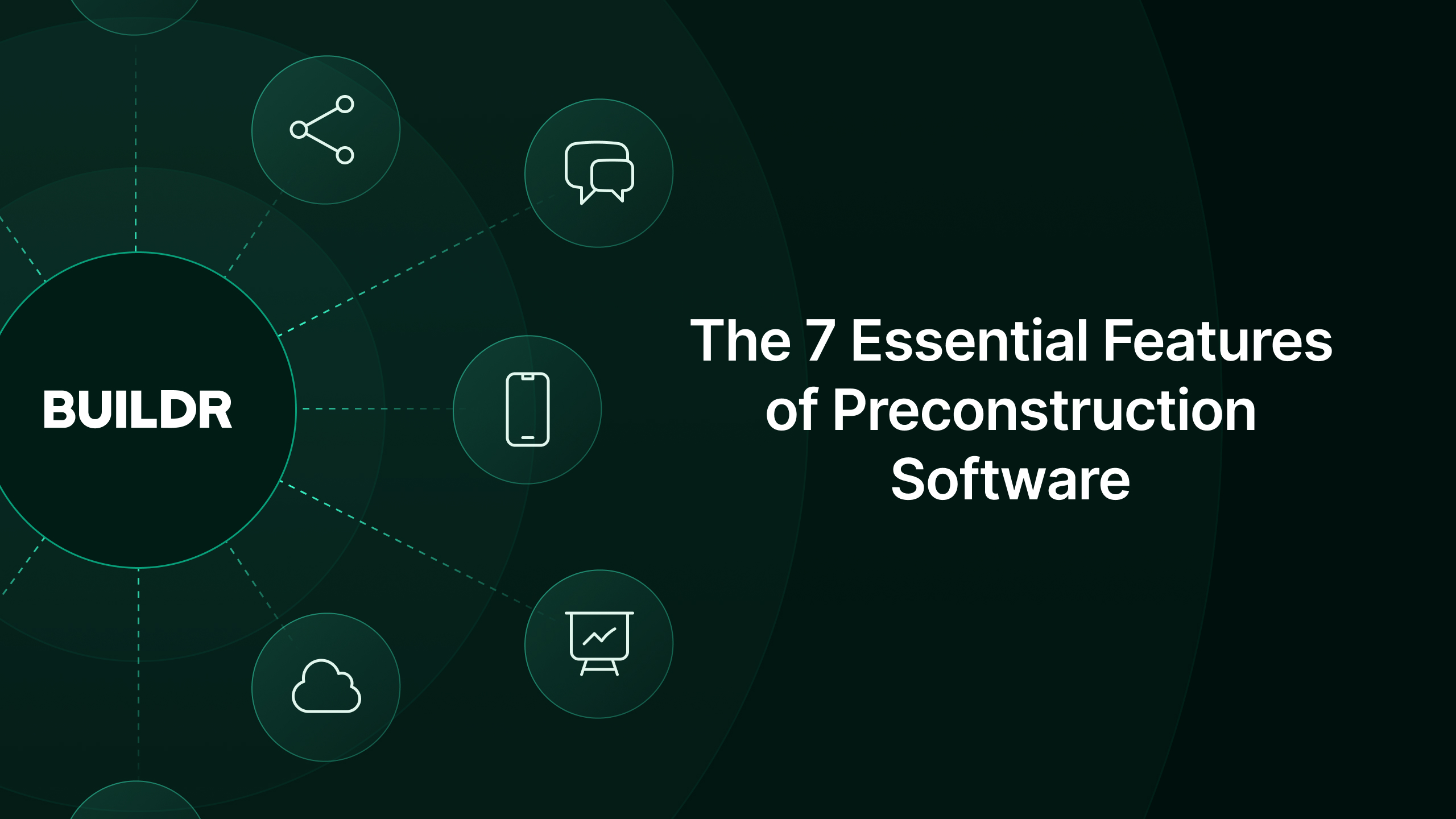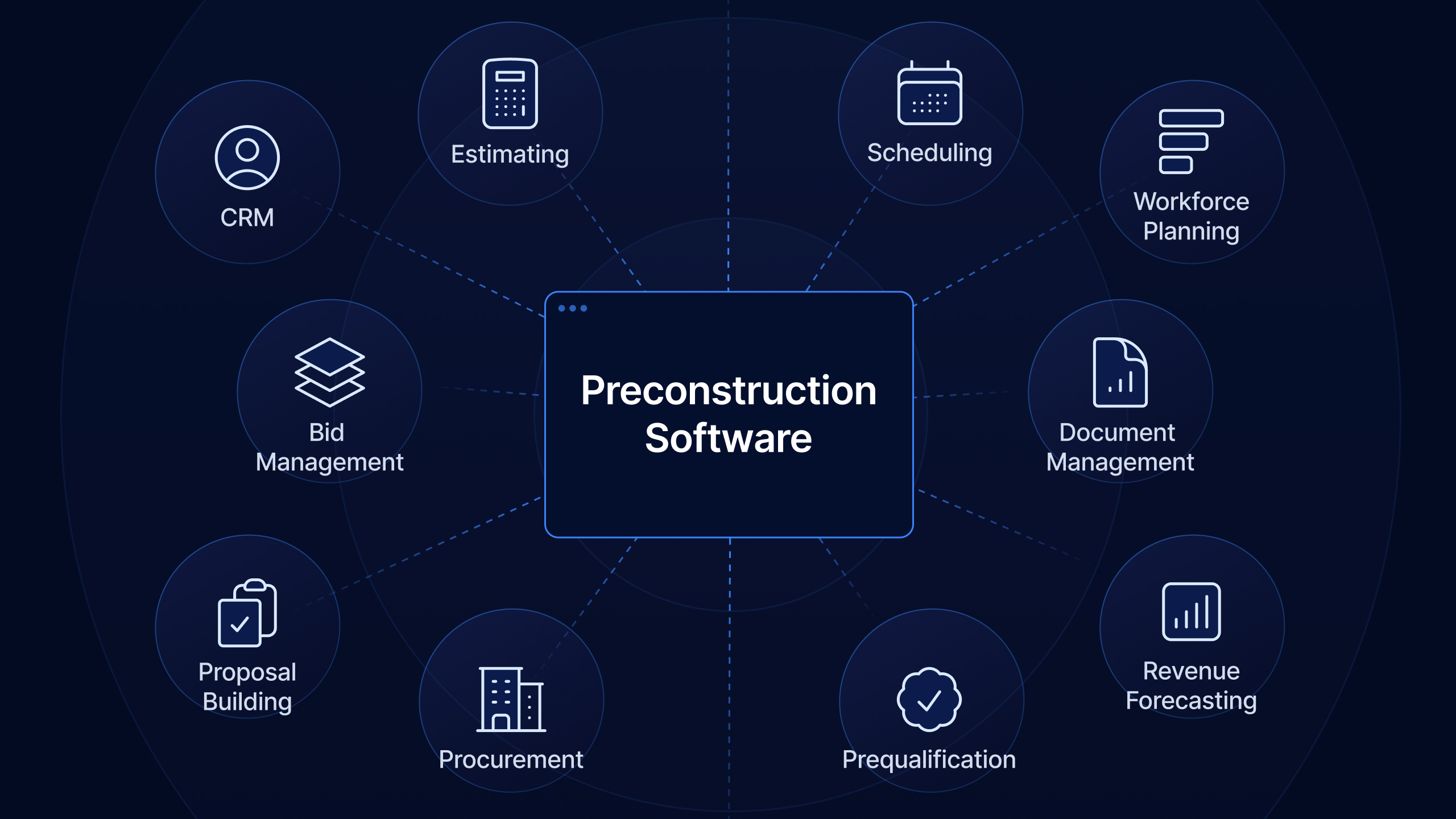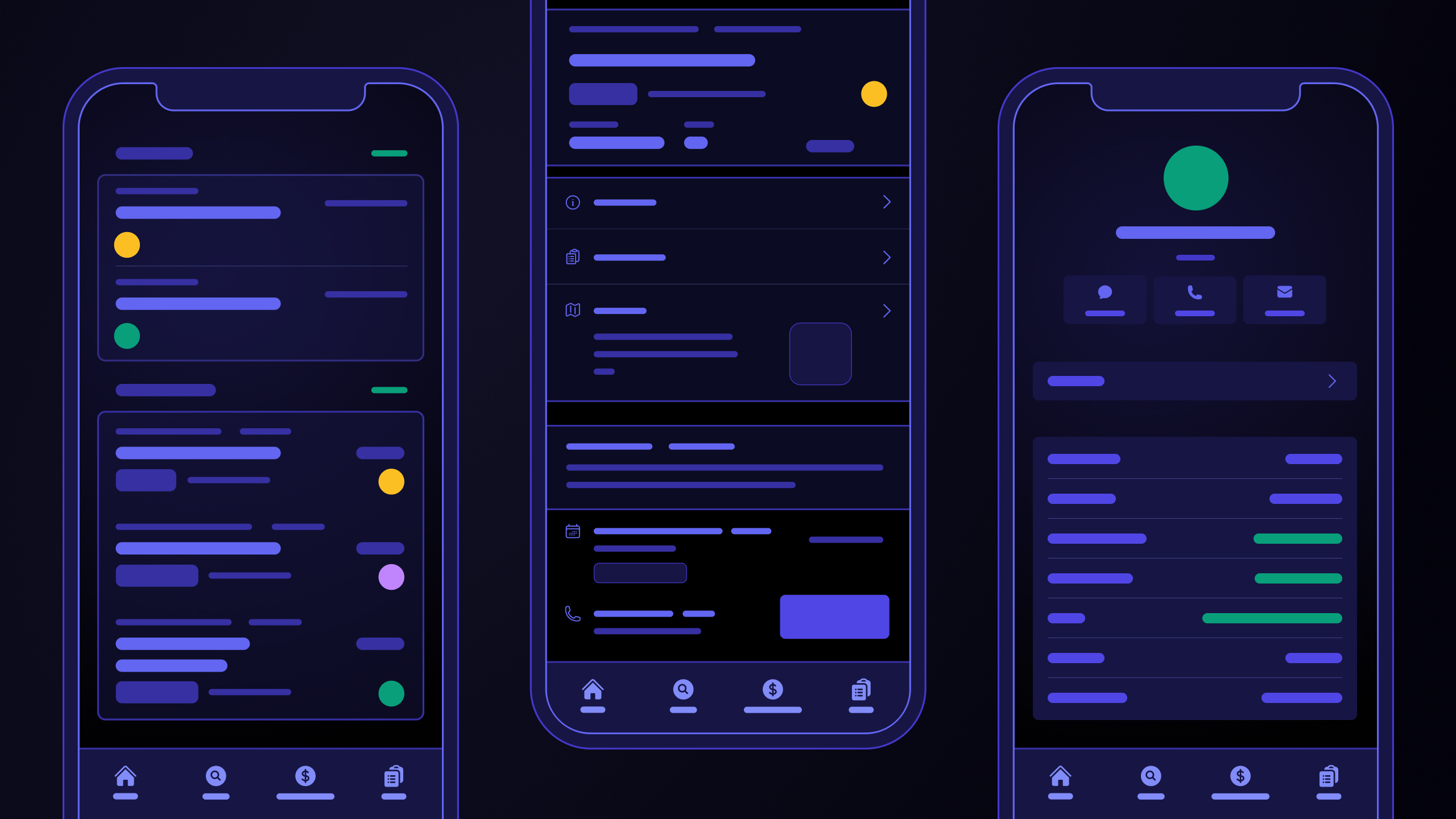
The 7 Essential Features of Preconstruction Software
Diving into the must-haves when vetting different preconstruction software
April 10, 2024
7 min read
Learnables

Edward Gonzalez
Founder at Buildr

From a quick Google search, you’ll find there are a bevy of solutions that bill themselves as preconstruction software out there. No need to feel overwhelmed; identifying the right solution for your company requires careful consideration of key features. This approach simplifies the decision-making process, enabling a straightforward comparison of the various preconstruction software options.
Below, we outline some features to consider during your evaluation process—the seven that we’ve deemed as the most broadly valuable for most general contractors.
Full disclosure: yes, all these features exist within Buildr. But whether you partner with Buildr or not, we still recommend preparing a comprehensive checklist of features that matter most to you and your company. This way you’ll ensure the most informed set of criteria for precon software that best aligns with your priorities.
For a more in-depth look at preconstruction software, including a breakdown of what it is, why it matters in 2024, and the various options out there, be sure to check out our blog: Preconstruction Software: The Comprehensive Guide.
1. User-friendliness is 10/10
"How intuitive is the user interface, and does this software provide guided workflows or tutorials to assist new users in navigating and utilizing its features effectively?"
Ask around, and you'll often hear that technology adoptions fail at general contractors because the software just simply wasn't user-friendly.
This holds true across all types of software, not just preconstruction tools. User-friendliness tops the list of essential attributes for a reason. When you're looking for software to enhance collaboration and efficiency, choosing a clunky or complicated system—just because it’s the industry norm or it’s made by the most "successful" company—just doesn't make much sense.
A user-friendly, intuitive preconstruction software means a faster, smoother setup process, a sleeker look, and ultimately, more satisfied teams. Moreover, a low learning curve ensures that team members, regardless of their technical aptitude, can quickly jump in and start using the software without a hitch.
Why preconstruction software adoption fails
As we said, a lack of user-friendliness is the most common reason that leads to software failing to be adopted properly by a general contractor. Some of the effort in educating navigation and best practices falls on the customer success and customer support teams of the tech company. But the user-friendliness of the product itself is going to decide longterm success or eventual failure.
Here are a few reasons why any type of new technology can sometimes fail at a business:
Lack of a champion or a poor champion
A champion, sometimes also referred to as a power user, is vital for technology adoption at any company. This person usually takes ownership of the initial vetting and eventual implementation process and acts as liaison between the tech company and the general contractor. They’re usually responsible for internally “selling” the rest of their company on the brighter future that includes this shiny new tool they’ve vetted.
If the champion person isn’t suited for this role, or they happen to leave the company, the GC can sometimes fumble the adoption process. It’s worth noting that software, if truly user-friendly, should be intuitive enough to not crash and burn if a single person leaves.
Lack of customization options
Sometimes a software can be deemed non-user-friendly if a general contractor can’t figure out a way to adapt their pre-existing processes to suit the preferred workflow of the new preconstruction software. Flexible customization is a core function of user-friendliness because it guarantees adapting a variety of processes can smoothly occur.
It’s just clunky
Sometimes a software’s user-interface is missing that special something and is simply hard or annoying to use. Maybe it’s outdated, maybe the page layouts aren’t clear and jumping between tabs isn’t obvious to navigate, maybe it just looks ugly. You should always jump in the tool get a feel for it before committing. Preconstruction software is difficult to adopt if it’s not fun to use.

2. There's centralized data
"Does this software offer a single, unified platform that allows for real-time access and management of all project-related data from any location?"
Having a unified data source is crucial for general contractors, as disjointed data often leads to increased administrative tasks, such as additional spreadsheets and meetings, and challenges in aligning efforts. This fragmentation can also increase the risk of data loss through human errors, staff turnover, or simple data misplacement (“Where was that one spreadsheet again?”).
By centralizing data, contractors can enhance access, streamline organization, and boost overall efficiency. The urgency for speed and maximizing available resources underlines the adoption of preconstruction software, making the centralization of data essential. Ensuring data is consistent and accurate necessitates adopting a single source of truth.
This understanding led us to create Buildr as a comprehensive preconstruction platform, rather than just another isolated point solution. The presence of numerous disparate preconstruction solutions can complicate data management, requiring data to navigate through multiple channels to remain synchronized. Buildr is designed to simplify this process, serving as a single, cohesive platform that maintains data integrity and consistency across the project lifecycle.
3. It's collaborative
"In what ways does your tool foster collaboration within and between precon teams?"
Since the preconstruction phrase has shortened since the pandemic, better collaboration is one surefire way to keep up the pace. Features within preconstruction software that enhance collaboration play a critical role in enabling instant communication and teamwork among all parties involved in a project.
The per-seat pricing model for software is outdated since it incentivizes juking the system and either limiting the amount of users or allowing multiple users to rely on a single user login at a time. Neither process is conducive to true collaboration and promotes the same data and team siloing that made you seek out software in the first place.
Collaborative features allow for the easy sharing of updates, the assignment of tasks through tagging, real-time updates, and better decision-making in less time. By promoting effective teamwork, collaborative tools help maintain alignment among team members, minimize unnecessary meetings, and prevent delays.
Such collaborative efforts effectively dismantle knowledge silos that impede progress. It's as if the entire team shares a collective brain, enabling your preconstruction units to operate with greater speed and flexibility. The era of isolated roles, like having a single individual manage your CRM (ever heard of that sort of setup?), is a thing of the past.
One value of a preconstruction platform, rather than a preconstruction point solution, is that you benefit from cross-departmental collaboration. "Before Buildr, I was the only person at our company using our CRM," said Jeffrey Forrest Jr., Director of Business Development at WPC. "On a weekly basis, I’d be extracting data out to share in meetings. Now, we have our entire executive and preconstruction teams in Buildr—it’s a living document that stays updated at all times that everyone has pulled up in meetings."
Note: Buildr features unlimited seats across all tiers to better promote collaboration between project teams.
4. It has a great mobile app
"How close to 1:1 to the software is the mobile experience?"
With smartphones becoming a permanent fixture in our lives, the existence of a good mobile app for preconstruction software is a must. A solid mobile app experience ensures that team members can access data anywhere, better communicate, and make critical decisions whether they're on a job site or enjoying a round of golf.
Yes, your team members can communicate already with just their phones. But if we're prioritizing capturing data in a living, breathing unified data hub, it's best to do it within the mobile app rather than texting or email where things will get harder to find as time goes by.
Of course, the quality of the mobile experience also matters. An inefficient mobile interface can be more detrimental than beneficial. For insights into the key features that make a preconstruction mobile app truly effective, don't miss our blog post on the subject: On the Go: 5 reasons to use Buildr's mobile app.

5. It integrates well with other software
"What other software does this one integrate with?"
When considering adopting preconstruction software, it's vital to evaluate how it will integrate with your existing tech stack for one simple goal: the death of duplicate data entry. Seamless integration with other construction management tools, including email and course-of-construction software, is essential for ensuring a smooth workflow, preventing data fragmentation, and boosting project efficiency.
This is particularly important as different departments tend to rely on various pieces of tech, and strong integration capabilities are key to maintaining effective collaboration. For point solutions within your tech stack, superior integration is crucial because their value lies in their ability to work in concert with other tools. Without effective communication between software components, data can become isolated, undermining the initial goals of implementing preconstruction software.
Note: Buildr comes integrated with Procore, a popular course-of-construction solution, out-of-the-box as well as Email/Office 365.
6. There's out-of-the-box business insights and reporting
"What's the out-of-the-box level of reporting with this software?"
The effectiveness of preconstruction software hinges on its capability to analyze and leverage data to refine strategic planning. Without this ability, the software risks becoming nothing more than an overpriced spreadsheet, failing to truly empower teams in their decision-making processes. It's essential for preconstruction platforms to provide insightful answers to pivotal questions, thereby facilitating more informed choices.
For insights into the top five features that enhance data reporting and analysis during the preconstruction phase, refer to the blog titled "Business Insights: Building a more informed future during preconstruction."
7. It's cloud-based
"Is this software cloud-based or on-premise?"
Nowadays, cloud-based software is all but ubiquitous due to its countless benefits over on-premise hardware.
Regardless, this list wouldn’t be complete without it since it’s absolutely essential. Cloud-based software is flexible and scalable no matter how large your company grows, there’s no fear of data loss, minimal security concerns, no upfront fees to install local servers, and it’s simple to get more data bandwidth if you need it. Overall, it’s much easier for organizations at every step from demoing through implementation through management to use cloud-based software instead of on-premise hardware.
Note: Buildr features unlimited data across all plans.
Cloud based, collaborative, user-friendly
Stay in the loop
Seriously, you should sign up to be a construction insider. Everyone will be so jealous of you.